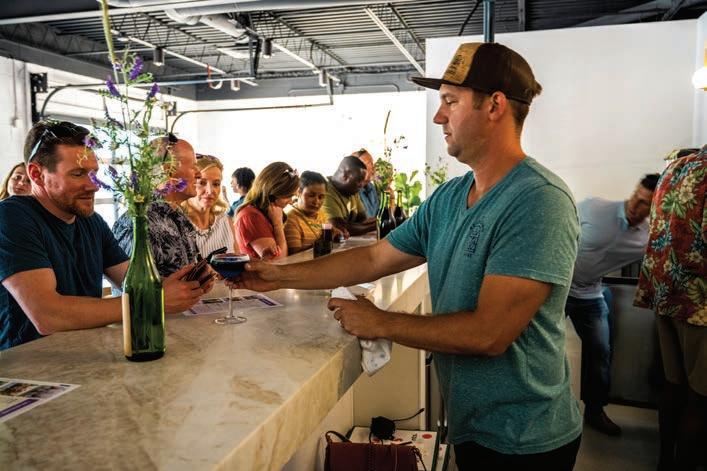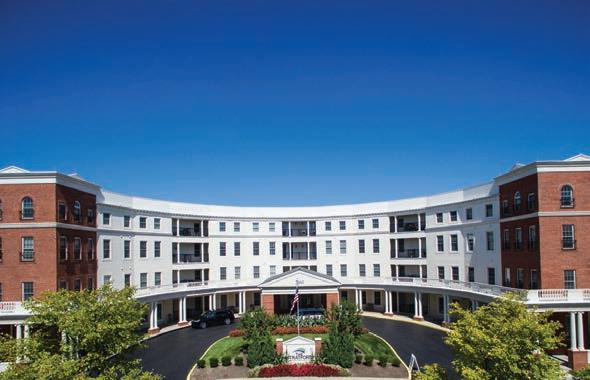
8 minute read
The Rejoicing Vine Winery
On Cultivating Life And Harvesting Joy
This month, Carmel Monthly is pleased to feature Carmel residents Brent and Frances Kumfer on the cover. The Kumfers have recently opened The Rejoicing Vine and shared with us their deep commitment to cultivating life through sustainable and regenerative farming practices while offering a destination for sparkling wine enthusiasts in a relaxing nature setting.
Advertisement
Meet The Kumfers
The Kumfers and their two children have called the north side “home” for the last 10 years. Brent is a native Hoosier from Fort Wayne, and Frances is from Connecticut. The couple met in Connecticut after Brent moved out east for eight years post-college. Brent and Frances shared their passion for frequenting the local [Connecticut] wineries along the “wine trail” while they were dating and that sparked an interest in what would be their future endeavor.
“When we were dating, we had a wine passport, and we would go around and get different stamps at different wineries,” Brent shared. “Once we collected enough stamps, we could submit the passport for a chance to win a trip to Spain. We loved doing that as we dated and had a lot of fun building our relationship. We found wine to be a great excuse to socialize. Once we started having kids and realized we had no time to sit around and have meaningful conversations, we found our friends and family members were in similar situations, so we thought we should start a winery and built it around this idea of connecting more with each other, our community and with nature.”
Frances added, “We have a 4-year-old and an 8-year-old, which is one of the reasons we moved to Carmel … for the great school system.” on which the winery operates two years ago in the Traders Point area of northern Marion County, just south of Boone County. In the early 2000s, it was formerly an orchid nursery.
“We renovated the [existing] building into our tasting room and wine production facility,” Brent said. “We have about 1,000 square feet of tasting room space and about 2,000 square feet of production space. We also have an outdoor patio space. Of the 16 acres, we have about 6 acres that are wooded. We currently farm 3 acres: 2 acres of planted vines, a ½ acre of apple trees and a ½ acre of raspberries.”

Frances added, “Our hope with the wooded area is to put [in] some walking/ running trails and set up [picnic] tables where people can enjoy wine and conversation out near the trails and in nature.”
The Kumfers’ overall mission is to serve the community, and they plan to do that in a myriad of ways.
“The first and obvious is through the tasting room,” Brent explained. “And by providing an atmosphere where families, friends and coworkers can come and enjoy time together, building community. The second [mission] is through connecting people with food. So, the walking trails, giving farm tours and talking with people about the importance of where and how their food is grown, and then the third aspect is giving back to the community.”
Once their apple trees begin producing fruit in the next few years, the Kumfers are planning on donating to local area food banks and food pantries.
“In the meantime, we want to give back some of our profits until we’re able to provide our own grown produce to support local organizations,” Brent stated.
DISPELLING A MYTH THAT INDIANA DOESN’T GROW GOOD GRAPES
“I would like to dispel that myth that you can’t grow good wine grapes here in Indiana,” Brent said. “The grapes that we can grow here do not make the same style of wines that you find in California, which has a very hot dry climate. They can grow the traditional grapes that were bred in Europe, and those grapes do not do well in our climate. So, we grow hybrids that are crosses between European varieties and American varieties. These are bred for cold hardiness and disease resistance.”
Brent explained that the hybrid wine grapes tend to be higher in acid and lower in tannins, which make it difficult to produce full-bodied reds.
“Tannins and acids don’t play well together on your palate,” Brent stated. “So, we are bucking this trend by producing sparkling wines. With sparkling wines, you actually want low tannins and high acid. It’s interesting to me that more wineries aren’t doing sparkling wines.”
Of the current offerings, The Rejoicing Vine produces a bottle-fermented brüt natural sparkling wine called the “Regenerative Rosé” with mouthwatering acidity and active yeast cultures.
“It’s a different take on a champagne-style wine and has very minimal residual sugar,” Brent said. “It’s one of our best sellers. It has an active yeast culture similar to kombucha or apple cider vinegar, and we believe that’s good for your gut microbiome.”
Frances added, “We’ve found the largest growth in wine drinking, in the younger generations, especially, are sparking wines and these kinds of ‘PétNat,’ or Pétillant Naturel, style wines that have yeast in them.”
“I think the younger consumers are looking for more approachable, lower alcohol drinks, and sparkling also fits that bill. Sparking wines are more in the range of 10-12 percent instead of 12-16 percent,” Brent stated.
Sustainable And Regenerative Farming
The Kumfers are making a concerted effort to reduce their carbon footprint and are buying everything regionally and/or locally.
“Sustainability is a big part of our mission, and we want to get everything as local as possible,” Brent expressed. And we farm regeneratively, which is a concept that I hope becomes more mainstream. The idea behind [regenerative] farming is a step up from sustainability. The idea of regenerative [farming] is to improve the environment that you’re farming to create healthy soils so you can get off the chemical treadmill of fertilizers and pesticides. Additionally, we can serve our [sparkling] wines on tap. Three of our four wines are on tap right now. Over the life of a keg, we can save close to 10,000 bottles from going into a landfill.”
FAMILY-FRIENDLY AND COMMUNITY-ORIENTED
The Kumfers invite families and even pets to come out and enjoy the natural scenery of the winery’s backdrop decorated with woods and wildflowers. Having partnered with local food artisans such as Tulip Tree Creamery and others, the winery offers a variety of healthy snacks and organic slushies. Check out the website for a full menu. Additionally, check out the upcoming events Bubbles & Brushes and Yoga For Life: Fundraiser for Suicide Prevention on the winery’s website!
The Rejoicing Vine is at 8440 W. 82nd Street, Indianapolis. For more information, visit the website at rejoicingvine.com.








relations and the cooperation between China and the City of Carmel.
As a current board member of the United States Heartland China Association, Brainard will lead a delegation of about eight U.S. mayors this fall to communities along the Yangtze River Valley area. The Yangtze River is the longest river in both China and Asia and is the third-longest river in the world. It is comparable to the Mississippi River valley region of the U.S. The mission of this trip, as well as of the USHCA organization, is to “foster and support a positive, productive, and mutually beneficial relationship between the people of the United States and China by creating more channels of collaboration and opportunities for economic growth in the American Heartland Region.”
A Brief History of USHCA
USHCA is a 501(c)(3) bipartisan organization committed to building bridges and promoting opportunities between the peoples of the Heartland Region [20 states located in the U.S. between the Great Lakes to the Gulf] and the People’s Republic of China. Its focus is on “Trust Building” efforts connecting government officials; business leaders; educational and community interests with like-minded institutions between the Heartland Region and the People’s Republic of China.

The original organization was founded in 2003 as the Midwest China Association by U.S. Senator Adlai Stevenson [IL]; John Rogers, lawyer and professor; and Governor Bob Holden [MO], former Chairman of the Midwest Governors Association. Holden is currently the organization’s Chairman and President. Its region covered 12 Midwestern states originally. In 2018, it expanded to serve 20 states from the Great Lakes to the Gulf of Mexico and changed its name to the United States
Heartland China Association.
As planning for the USHCA trip to China is well underway, Brainard shared that he, along with his fellow U.S. mayors and their Chinese counterparts, will engage in seminars and agricultural roundtable discussions for approximately 10 days.
Building Diplomatic Ties at the City Level
Diplomatic relations between China and the U.S. are of paramount importance at both the national and sub-national levels, including at the state and city levels. These relations have a significant impact on various aspects of political, economic, cultural and social exchanges between the two countries.
Major cities in both China and the U.S. serve as economic powerhouses. Establishing diplomatic ties at the city level can facilitate direct trade and investment between cities, leading to increased prosperity and development. Cities in both the U.S. and China face common challenges like climate change, urbanization and public health. Diplomatic relations at the city level can facilitate the sharing of best practices and innovative solutions to address these issues.
“This was an important meeting to have with Zhao Jian and his staff,” Brainard said. “Although there are issues of disagreement between China and the United States, it is vital to talk to each other. Strong diplomatic relations between China and the U.S. at the state and city level can create a conducive environment for collaboration, economic growth and cultural exchange. These relationships, in turn, contribute to the understanding between the two nations and can potentially have a positive influence on the overall bilateral relations at the national level.”
Brainard’s Meeting With the Chinese Consul General
A Consul General is a diplomatic representative of a country appointed to oversee and promote the interests of their home country in a foreign city. The Consul General operates under the authority of the embassy or the diplomatic mission of their home country, which is usually located in the capital city of the host country. Consulates are established in various cities of a country to provide consular services and support to its citizens residing or traveling in that region.
“Diplomacy should not necessarily be done [solely] at the federal level,” Brainard said. “It is especially important, when nations are in disagreement with one another, for people representing all walks of life to talk with people in the other country, recognizing that trade and direct foreign investments are good and cement friendships. While we may disagree on many issues, it is important to look for the issues that we have in common and the values that we do agree on. It’s important to keep conversations open. Not communicating with people who have different ideas is never the solution.”
The City of Carmel is home to a large number of people who are originally from China and who own companies or are employed by Chinese-owned businesses in Carmel.
“It is important to have these cultural exchanges [locally and abroad] to get to know each other and understand each other,” Brainard emphasized. “Doing that city by city [throughout the U.S. and China] assists with decreasing the chances of having escalated conflicts. And we want what’s called foreign direct investment. We want companies to have U.S. headquarters in Carmel as opposed to some other city in the U.S. It is good for our economy and workforce development.”

During the meeting with Mr. Zhao Jian, which lasted nearly two hours, Brainard shared that they discussed China’s need for better health care for its people, more access to affordable and available flights to the U.S., and the need to purchase high-quality protein and milk from the U.S.

“We also discussed that we need to work more on climate initiatives, of course — he knew that is an interest of mine,” Brainard said. “It was a friendly visit, and he talked about how beautiful Carmel is. They had driven down from Chicago and had driven around the city before the meeting. He mentioned that they have also been in the city-building business, as there’s been a huge shift in populations from rural areas to cities.”
For more information on the United States Heartland China Association, visit usheartlandchina.org.
A total of 430 Fortune 1000 companies are headquartered in 84 of the cities within the Heartland region. USHCA mayors lead 37 of the 100 largest cities in the United States. The U.S. national GDP ranks first in the world. Remove the U.S. Heartland region from this analysis, and the European Union would rank first, China second, U.S. third.







